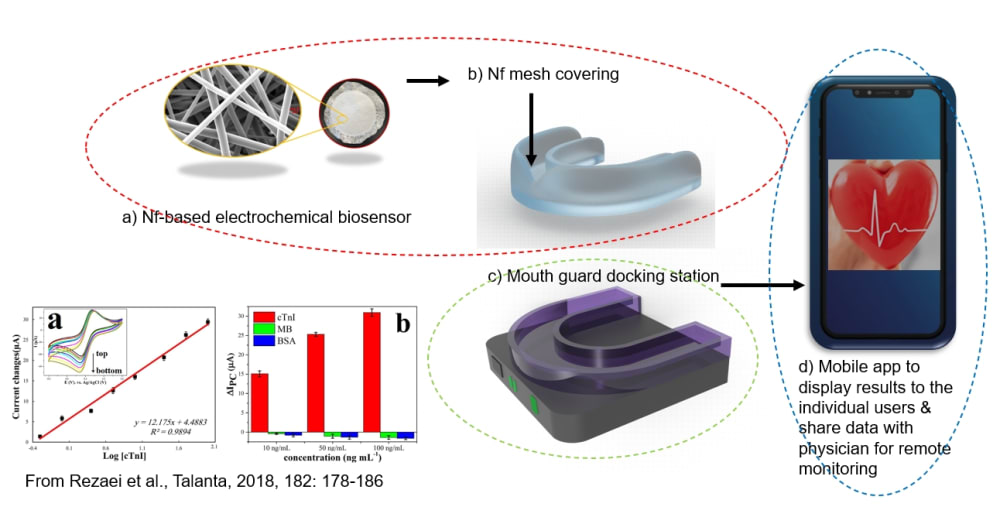
Our long-term goal is to develop home-based wearable technology solutions to detect and monitor health conditions indicated by disease-specific biomarkers from the saliva in real-time. Disease prevention is the secret to longevity. A healthy lifestyle combined with disease prevention can protect, promote, and maintain health and well-being and to prevent disease, disability, and death. Early detection of disease and continuous monitoring enables prompt treatment that can prevent disease progression and costly health outcomes. For this specific project, we will focus on a nanotechnology-based biosensor targeting salivary biomarkers to detect and monitor heart failure.
Saliva is known to contain many clinical biomarkers specific to cardiovascular diseases. In comparison to blood collection, saliva collection is truly non-invasive and is especially appropriate for elderly patients who require repeated collections. Therefore, continual monitoring of fresh saliva using wearable biosensor will allow for real-time monitoring of biomarkers associated with heart disease at home. Electrospinning is a fascinating technique to fabricate nanofibrous (NF) hierarchical architecture to provide a unique environment for biosensing due to controlled fluid delivery and retention ability to facilitate direct electron transfer. NF enables the loading of biomolecules to efficiently interact with the analytes, increasing the specificity and sensitivity of the biosensor. Moreover, it is feasible to increase the electrical conductivity of the nanofiber by adding ionic salts or conductive material like gold or graphene in solution to the electrospinning process. As a result, it can be an ideal technology to noninvasively detect the changes in conductivity due to the amount of concentration of a specific biomarker from saliva for remote patient monitoring for heart failure. We therefore hypothesize that a NF-based biosensor will provide a reliable and robust way to detect congestive heart failure (CHF) based on the electrically conductive variability of a specific biomarker concentration from saliva.
Our approach focuses on using a nanomesh biosensor developed via electrospinning technique for a non-invasive analysis of CHF biomarkers found in saliva at home. The innovation of this approach lies in the rational design of a breathable biosensor with three-dimensional (3D) architecture, which will facilitate the optimal selection and detection of the biomarkers based on their concentration within the 3D layers with high responsiveness and sensitivity. It is also novel in that it will pave the new way for a long-term reliable disease diagnosis, monitoring, and early detection, as well as opens an opportunity for non-invasive personalized remote patient monitoring based on clinical biomarkers for healthy aging.
-
Awards
-
 2022 Top 100 Entries
2022 Top 100 Entries
Like this entry?
-
About the Entrant
- Name:Hongwu Wang
- Type of entry:teamTeam members:Hongwu Wang, Assistant Professor, University of Florida, USA
Dubey Nileshkumar, Assistant Professor, National University of Singapore, Singapore
Penaloza Christian, Principal Researcher, Mirai Innovation Research Institute, Japan - Software used for this entry:Labview
- Patent status:pending








